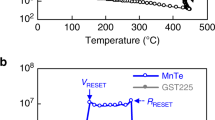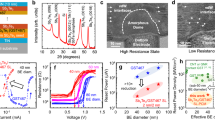Abstract
Phase-change materials are some of the most promising materials for data-storage applications. They are already used in rewriteable optical data storage and offer great potential as an emerging non-volatile electronic memory. This review looks at the unique property combination that characterizes phase-change materials. The crystalline state often shows an octahedral-like atomic arrangement, frequently accompanied by pronounced lattice distortions and huge vacancy concentrations. This can be attributed to the chemical bonding in phase-change alloys, which is promoted by p-orbitals. From this insight, phase-change alloys with desired properties can be designed. This is demonstrated for the optical properties of phase-change alloys, in particular the contrast between the amorphous and crystalline states. The origin of the fast crystallization kinetics is also discussed.
This is a preview of subscription content, access via your institution
Access options
Subscribe to this journal
Receive 12 print issues and online access
$259.00 per year
only $21.58 per issue
Buy this article
- Purchase on Springer Link
- Instant access to full article PDF
Prices may be subject to local taxes which are calculated during checkout



© 2001 APS

© 2006 AIP




Similar content being viewed by others
References
Meinders, E. R., Mijritskii, A. V., van Pieterson, L. & Wuttig, M. Optical Data Storage: Phase Change Media and Recording (Springer, Berlin, 2006).
Yamada, N. et al. High-speed overwritable phase-change optical disk material. Jpn. J. Appl. Phys. Part 1 26, 61–66 (1987).
Satoh, I. & Yamada, N. DVD-RAM for all audio/video, PC, and network applications. Proc. SPIE 4085, 283–290 (2001).
Ovshinsky, S. R. Reversible electrical switching phenomena in disordered structures. Phys. Rev. Lett. 21, 1450–1453 (1968).
Wuttig, M. Phase-change materials—towards a universal memory? Nature Mater. 4, 265–266 (2005).
Luo, M. B. & Wuttig, M. The dependence of crystal structure of Te-based phase-change materials on the number of valence electrons. Adv. Mater. 16, 439–443 (2004).
Chen, M., Rubin, K. A. & Barton, R. W. Compound materials for reversible, phase-change optical-data storage. Appl. Phys. Lett. 49, 502–504 (1986).
Yamada, N., Takenaga, M. & Takao, M. Te–Ge–Sn–Au phase-change recording film for optical disk. Proc. SPIE 695, 79–85 (1986).
Ohno, E., Yamada, N., Kurumizawa, T., Kimura, K. & Takao, M. Tegesnau alloys for phase-change type optical disk memories. Jpn. J. Appl. Phys. Part 1 28, 1235–1240 (1989).
Yamada, N., Ohno, E., Nishiuchi, K., Akahira, N. & Takao, M. Rapid-phase transitions of GeTe–Sb2Te3 pseudobinary amorphous thin-films for an optical disk memory. J. Appl. Phys. 69, 2849–2856 (1991).
Kojima, R. et al. Nitrogen doping effect on phase change optical disks. Jpn. J. Appl. Phys. Part 1 37, 2098–2103 (1998).
Kojima, R. & Yamada, N. Acceleration of crystallization speed by Sn addition to Ge–Sb–Te phase-change recording material. Jpn. J. Appl. Phys. Part 1 40, 5930–5937 (2001).
Yusu, K., Nakai, T., Ashida, S., Ohmachi, N., Morishita, N. & Nakamura, N. Highspeed crystallization characteristics of Ge–Sb–Te–Bi materials used for next generation rewritable DVD with blue laser and NA = 0.65. Proc. E\\PCOS05 (2005); available at http://www.epcos.org.
Kusada, H., Hosaka, T., Kojima R. & Yamada, N. Effect of excess Sb on GeTe–Sb2Te3–Bi2Te3 recording films. Proc. 18th Symp. PCOS2005 32–35 (2006).
Iwasaki, H., Ide, Y., Harigaya, M., Kageyama, Y. & Fujimura, I. Completely erasable phase-change optical disk. Jpn. J. Appl. Phys. Part 1 31, 461–465 (1992).
Horie, M., Nobukuni, N., Kiyono, K. & Ohno, T. High-speed rewritable DVD up to 20 m/s with nucleation-free eutectic phase-change material of Ge(Sb70Te30)+Sb. Proc. SPIE 4090, 135–143 (2000).
Kato, T. et al. The phase change optical disc with the data recording rate of 140 Mbps. Jpn. J. Appl. Phys. Part 1 41, 1664–1667 (2002).
Iwasaki, H. et al. Completely erasable phase-change optical disc. II. Application of Ag–In–Sb–Te mixed-phase system for rewritable compact disc compatible with CD-velocity and double CD-velocity. Jpn. J. Appl. Phys. Part 1 32, 5241–5247 (1993).
Afonso, C. N., Solis, J., Catalina, F. & Kalpouzos, C. Ultrafast reversible phase-change in GeSb films for erasable optical storage. Appl. Phys. Lett. 60, 3123–3125 (1992).
Yuzurihara, H., Iwasa, H. & Kaneko, Y. GeSbSnMn for high speed BD-RE media. Proc. 17th Symp. PCOS2005 19–22 (2005).
Yamada, N. & Matsunaga, T. Structure of laser-crystallized Ge2Sb2+ xTe5 sputtered thin films for use in optical memory. J. Appl. Phys. 88, 7020–7028 (2000).
Matsunaga, T. & Yamada, N. A study of highly symmetrical crystal structures, commonly seen in high-speed phase-change materials, using synchrotron radiation. Jpn. J. Appl. Phys. Part 1 41, 1674–1678 (2002).
Matsunaga, T. & Yamada, N. Crystallographic studies on high-speed phase-change materials used for rewritable optical recording disks. Jpn. J. Appl. Phys. Part 1 43, 4704–4712 (2004).
Nonaka, T., Ohbayashi, G., Toriumi, Y., Mori, Y. & Hashimoto, H. Crystal structure of GeTe and Ge2Sb2Te5 meta-stable phase. Thin Solid Films 370, 258–261 (2000).
Matsunaga, T. & Yamada, N. Crystal structure and bonding nature of Ge8Sb2Te11, a suitable material for high-speed, high density phase-change recording. Proc. 16th Symp. PCOS2004 1–4 (2005).
Kolobov, A. V. et al. Understanding the phase-change mechanism of rewritable optical media. Nature Mater. 3, 703–708 (2004).
Matsunaga, T., Umetani, Y. & Yamada, N. Structural study of a Ag3.4In3.7Sb76.4Te16.5 quadruple compound utilized for phase-change optical disks. Phys. Rev. B 64, 184116 (2001).
Zallen, R. Models of amorphous solids. J. Non-Cryst. Solids 75, 3–14 (1985).
Zachariasen, W. The atomic arrangement in glass. J. Am. Chem. Soc. 54, 3841–3851 (1932).
Thorpe, M. F. Continuous deformations in random networks. J. Non-Cryst. Solids 57, 355–370 (1983).
Phillips, J. C. & Thorpe, M. F. Constraint theory, vector percolation and glass-formation. Solid State Commun. 53, 699–702 (1985).
Feng, X. W., Bresser, W. J. & Boolchand, P. Direct evidence for stiffness threshold in chalcogenide glasses. Phys. Rev. Lett. 78, 4422–4425 (1997).
Welnic, W. et al. Unravelling the interplay of local structure and physical properties in phase-change materials. Nature Mater. 5, 56–62 (2006).
Wełnic, W., Botti, S., Reining, L. & Wuttig, M. Origin of the optical contrast in phase change materials. Phys. Rev. Lett. 98, 236403 (2007).
Debenedetti, P. G. & Stillinger, F. H. Supercooled liquids and the glass transition. Nature 410, 259–267 (2001).
Baker, D. A., Paesler, M. A., Lucovsky, G., Agarwal, S. C. & Taylor, P. C. Application of bond constraint theory to the switchable optical memory material Ge2Sb2Te5 . Phys. Rev. Lett. 96, 255501 (2006).
Kohara, S. et al. Structural basis for the fast phase change of Ge2Sb2Te5: ring statistics analogy between the crystal and amorphous states. Appl. Phys. Lett. 89, 201910 (2006).
Kalb, J., Spaepen, F. & Wuttig, M. Calorimetric measurements of phase transformations in thin films of amorphous Te alloys used for optical data storage. J. Appl. Phys. 93, 2389–2393 (2003).
Kalb, J., Spaepen, F. & Wuttig, M. Atomic force microscopy measurements of crystal nucleation and growth rates in thin films of amorphous Te alloys. Appl. Phys. Lett. 84, 5240–5242 (2004).
Kalb, J. A., Wuttig, M. & Spaepen, F. Calorimetric measurements of structural relaxation and glass transition temperatures in sputtered films of amorphous Te alloys used for phase change recording. J. Mater. Res. 22, 748–754 (2007).
Turnbull, D. Under what conditions can a glass be formed? Contemp. Phys. 10, 473–488 (1969).
Kalb, J. A., Spaepen, F. & Wuttig, M. Kinetics of crystal nucleation in undercooled droplets of Sb- and Te-based alloys used for phase change recording. J. Appl. Phys. 98, 054910 (2005).
Friedrich, I., Weidenhof, V., Lenk, S. & Wuttig, M. Morphology and structure of laser-modified Ge2Sb2Te5 films studied by transmission electron microscopy. Thin Solid Films 389, 239–244 (2001).
Chen, Y. C. et al. Ultra-thin phase-change bridge memory device using GeSb. IEDM Tech. Digest 777–780 (2006).
Friedrich, I., Weidenhof, V., Njoroge, W., Franz, P. & Wuttig, M. Structural transformations of Ge2Sb2Te5 films studied by electrical resistance measurements. J. Appl. Phys. 87, 4130–4134 (2000).
Coombs, J. H., Jongenelis, A. P. J. M., Vanesspiekman, W. & Jacobs, B. A. J. Laser-induced crystallization phenomena in GeTe-based alloys. 2. Composition dependence of nucleation and growth. J. Appl. Phys. 78, 4918–4928 (1995).
Weidenhof, V., Pirch, N., Friedrich, I., Ziegler, S. & Wuttig, M. Minimum time for laser induced amorphization of Ge2Sb2Te5 films. J. Appl. Phys. 88, 657–664 (2000).
Anderson, P. W. Absence of diffusion in certain random lattices. Phys. Rev. 109, 1492–1505 (1958).
Njoroge, W. K., Woltgens, H. W. & Wuttig, M. Density changes upon crystallization of Ge2Sb2.04Te4.74 films. J. Vac. Sci. Technol. A 20, 230–233 (2002).
Yamada, N. et al. Phase-change material for use in rewritable dual-layer optical disk. Proc. SPIE 4342, 55–63 (2002).
Onida, G., Reining, L. & Rubio, A. Electronic excitations: density-functional versus many-body Green's-function approaches. Rev. Mod. Phys. 74, 601–659 (2002).
Stuke, J. & Zimmerer, G. Optical properties of amorphous 3–5 compounds.1. Experiment. Phys. Status Solidi B 49, 513–523 (1972).
Wuttig, M. et al. The role of vacancies and local distortions in the design of new phase-change materials. Nature Mater. 6, 122–128 (2007).
Peierls, R. E. Quantum Theory of Solids (Oxford Univ. Press, Oxford, 1956).
Gaspard, J. P. Hume–Rothery rule in V–VI compounds. Solid State Commun. 84, 839–842 (1992).
Gaspard, J. P., Pellegatti, A., Marinelli, F. & Bichara, C. Peierls instabilities in covalent structures. I. Electronic structure, cohesion and the Z = 8 − N rule. Phil. Mag. B 77, 727–744 (1998).
Nakano, T., Sato, A., Fuji, H., Tominaga, J. & Atoda, N. Transmitted signal detection of optical disks with a superresolution near-field structure. Appl. Phys. Lett. 75, 151–153 (1999).
Tominaga, J., Fuji, H., Sato, A., Nakano, T. & Atoda, N. The characteristics and the potential of super resolution near-field structure. Jpn. J. Appl. Phys. Part 1 39, 957–961 (2000).
Kim, J. et al. Super-resolution near-field structure with alternative recording and mask materials. Jpn. J. Appl. Phys. Part 1 42, 1014–1017 (2003).
Cho, W. Y. et al. A 0.18-μm 3.0-V 64-Mb nonvolatile phase-transition random access memory (PRAM). IEEE J. Solid-State Circuits 40, 293–300 (2005).
Hudgens, S. & Johnson, B. Overview of phase-change chalcogenide nonvolatile memory technology. Mater. Res. Soc. Bull. 29, 829–832 (2004).
Bez, R. & Pirovano, A. Non-volatile memory technologies: emerging concepts and new materials, Mater. Sci. Semicond. Proc. 7, 349–355 (2004).
Lankhorst, M. H. R., Ketelaars, B. W. S. M. M. & Wolters, R. A. M. Low-cost and nanoscale non-volatile memory concept for future silicon chips. Nature Mater. 4, 347–352 (2005).
Hanzawa, S. et al. A 512 kB embedded phase change memory with 416 kb/s write throughput 100 μA cell write current. ISSCC Digest Tech. 474–475 (2007).
Pirovano, A., Lacaita, A. L., Benvenuti, A., Pellizzer, F. & Bez, R. Electronic switching in phase-change memories. IEEE Trans. Electron Devices 51, 452–459 (2004).
Merget, F., Kim, D. H., Bolivar, P. Η. & Kurz, H. Lateral phase change random access memory cell design for low power operation. Microsyst. Technol. 13, 169–172 (2007).
Kim, D. H., Merget, F., Forst, M. & Kurz, H. Threedimensional simulation model of switching dynmics in phase change random access memory cells. J. Appl. Phys. 101, 064512–1 (2007).
Kastner, M., Adler, D. & Fritsche, H. Valence-alternation model for localized gap states in lone-pair semiconductors. Phys. Rev. Lett. 37, 1504–1507 (1976).
Waser, R. & Aono, M. Nanoionics-based resistive switching memories. Nature Mater. 6, 833–840 (2007).
Lu, W. & Lieber, C. M. Nanoelectronics from the bottom up. Nature Mater. 6, 841–850 (2007).
Acknowledgements
We thank J. Kalb and M. Salinga for critical reading of the manuscript and the European project WIND for financial support.
Author information
Authors and Affiliations
Corresponding author
Rights and permissions
About this article
Cite this article
Wuttig, M., Yamada, N. Phase-change materials for rewriteable data storage. Nature Mater 6, 824–832 (2007). https://doi.org/10.1038/nmat2009
Issue Date:
DOI: https://doi.org/10.1038/nmat2009
This article is cited by
-
Versatile spaceborne photonics with chalcogenide phase-change materials
npj Microgravity (2024)
-
Unravelling the amorphous structure and crystallization mechanism of GeTe phase change memory materials
Nature Communications (2024)
-
Novel nanocomposite-superlattices for low energy and high stability nanoscale phase-change memory
Nature Communications (2024)
-
Emerging memory electronics for non-volatile radiofrequency switching technologies
Nature Reviews Electrical Engineering (2024)
-
Analysis of Charge Distributions in Functional Transition-Metal Tellurides
Topics in Catalysis (2024)



